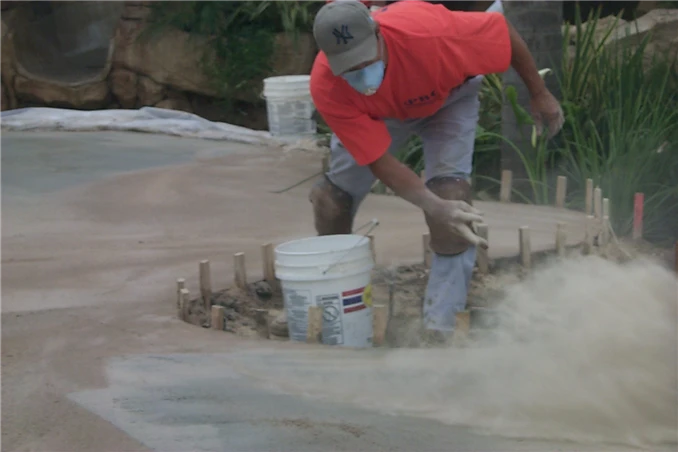The Eternal Debate: Color Hardener vs Integral Color
Few debates are as intense as the one between color hardener and integral color. Often the decision is based on the application, but personal preference plays a big part. Read on to discover the pros and cons of both choices.

Color Hardener
Color Hardener is a surface applied cementitious material. It is generally applied by hand when finishing concrete. Color Hardener reacts with the excess bleedwater at the surface of the slab and is floated in.
Pros
Color Hardener, as the name implies, forms a denser surface that is more durable and resistant to abrasion. This increases the lifespan and performance of the flatwork. Because it is a surface applied product, Color Hardener can also provide more flexibility. It can be used to color portions of a project without necessitating separate concrete orders (for example, a 9 yard job that requires two or more colors would only require one load of standard concrete). Furthermore, advanced techniques (even in conjunction with integral color) can yield different aesthetic effects such as marbling.
Cons
Color Hardener requires more time, effort, and skill on the part of the finishers when compared to integral color. Poorly applied Color Hardener can later delaminate when exposed to the elements and wear. Depending on application method and conditions, Color Hardener can be rather messy, broadcasting pigmented powder into the air to cover unprotected surfaces. Color Hardener is also generally limited to flatwork and may not be applicable in low bleedwater circumstances.
Integral Color
Integral Color is pigment, frequently derived from iron oxide, which is mixed into the wet concrete before placement. Integral color can be added in powdered, liquid, or granular form. Each of these methods has its own benefits and drawbacks.
Pros
For the contractor, Integral Color represents little to no additional labor when compared to unpigmented concrete. All coloring is managed at the ready mix plant during the batching process or by simply adding the appropriate amount of pigment to the truck at the jobsite and allowing it to mix. As the color is distributed throughout the concrete, Integral Color is a good option when complicated or vertical surfaces would otherwise complicate the inclusion of Color Hardener. Finally, especially when the ready mix plant or distributor utilizes and liquid color or granular system, custom color blends are more readily available.
Cons
As it is typically added at the ready mix plant, Integral Color does remove some level of control from the contractor. Coloration is also more highly affected by mix design and impurities within the concrete, making it more difficult to maintain consistent color over the course of a larger project.
There is no right or wrong. The choice depends on personal preference, applicator skill, and the specifications for the job. In either case, quality products can be found at your nearest Solomon Colors or Brickform distributor.
See More

